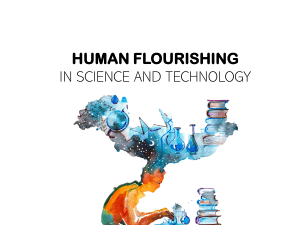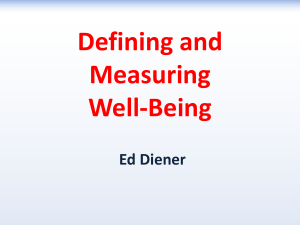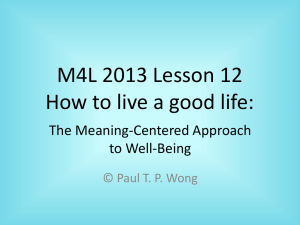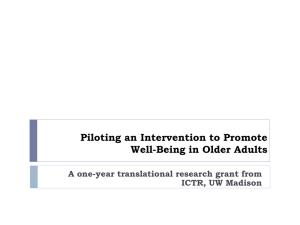poster Osin Boniwell
advertisement
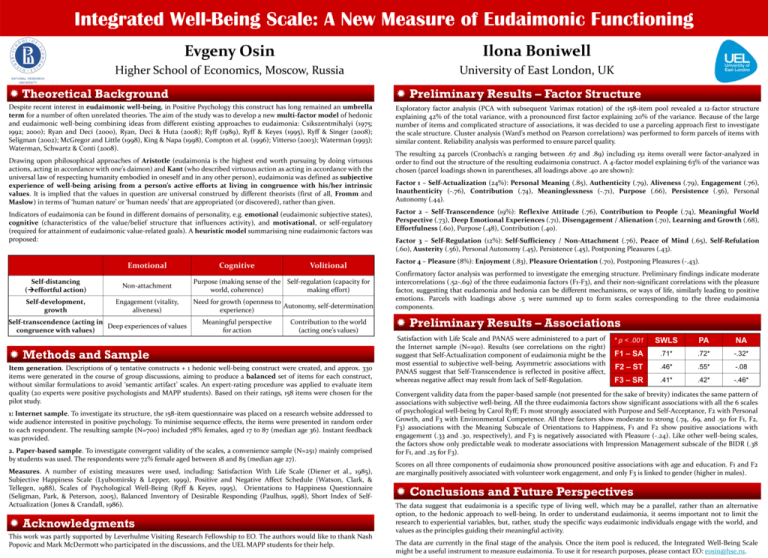
Integrated Well-Being Scale: A New Measure of Eudaimonic Functioning Evgeny Osin Ilona Boniwell Higher School of Economics, Moscow, Russia University of East London, UK Theoretical Background Preliminary Results – Factor Structure Despite recent interest in eudaimonic well-being, in Positive Psychology this construct has long remained an umbrella term for a number of often unrelated theories. The aim of the study was to develop a new multi-factor model of hedonic and eudaimonic well-being combining ideas from different existing approaches to eudaimonia: Csikszentmihalyi (1975; 1992; 2000); Ryan and Deci (2000), Ryan, Deci & Huta (2008); Ryff (1989), Ryff & Keyes (1995), Ryff & Singer (2008); Seligman (2002); McGregor and Little (1998), King & Napa (1998), Compton et al. (1996); Vitterso (2003); Waterman (1993); Waterman, Schwartz & Conti (2008). Exploratory factor analysis (PCA with subsequent Varimax rotation) of the 158-item pool revealed a 12-factor structure explaining 42% of the total variance, with a pronounced first factor explaining 20% of the variance. Because of the large number of items and complicated structure of associations, it was decided to use a parceling approach first to investigate the scale structure. Cluster analysis (Ward’s method on Pearson correlations) was performed to form parcels of items with similar content. Reliability analysis was performed to ensure parcel quality. Drawing upon philosophical approaches of Aristotle (eudaimonia is the highest end worth pursuing by doing virtuous actions, acting in accordance with one’s daimon) and Kant (who described virtuous action as acting in accordance with the universal law of respecting humanity embodied in oneself and in any other person), eudaimonia was defined as subjective experience of well-being arising from a person’s active efforts at living in congruence with his/her intrinsic values. It is implied that the values in question are universal construed by different theorists (first of all, Fromm and Maslow) in terms of ‘human nature’ or ‘human needs’ that are appropriated (or discovered), rather than given. Indicators of eudaimonia can be found in different domains of personality, e.g. emotional (eudaimonic subjective states), cognitive (characteristics of the value/belief structure that influences activity), and motivational, or self-regulatory (required for attainment of eudaimonic value-related goals). A heuristic model summarising nine eudaimonic factors was proposed: Emotional Cognitive Volitional Self-distancing (effortful action) Non-attachment Purpose (making sense of the Self-regulation (capacity for world, coherence) making effort) Self-development, growth Engagement (vitality, aliveness) Need for growth (openness to Autonomy, self-determination experience) Self-transcendence (acting in Deep experiences of values congruence with values) Meaningful perspective for action Contribution to the world (acting one’s values) Methods and Sample Item generation. Descriptions of 9 tentative constructs + 1 hedonic well-being construct were created, and approx. 330 items were generated in the course of group discussions, aiming to produce a balanced set of items for each construct, without similar formulations to avoid ‘semantic artifact’ scales. An expert-rating procedure was applied to evaluate item quality (2o experts were positive psychologists and MAPP students). Based on their ratings, 158 items were chosen for the pilot study. 1: Internet sample. To investigate its structure, the 158-item questionnaire was placed on a research website addressed to wide audience interested in positive psychology. To minimise sequence effects, the items were presented in random order to each respondent. The resulting sample (N=700) included 78% females, aged 17 to 87 (median age 36). Instant feedback was provided. 2. Paper-based sample. To investigate convergent validity of the scales, a convenience sample (N=251) mainly comprised by students was used. The respondents were 72% female aged between 18 and 85 (median age 27). Measures. A number of existing measures were used, including: Satisfaction With Life Scale (Diener et al., 1985), Subjective Happiness Scale (Lyubomirsky & Lepper, 1999), Positive and Negative Affect Schedule (Watson, Clark, & Tellegen, 1988), Scales of Psychological Well-Being (Ryff & Keyes, 1995), Orientations to Happiness Questionnaire (Seligman, Park, & Peterson, 2005), Balanced Inventory of Desirable Responding (Paulhus, 1998), Short Index of SelfActualization (Jones & Crandall, 1986). Acknowledgments This work was partly supported by Leverhulme Visiting Research Fellowship to EO. The authors would like to thank Nash Popovic and Mark McDermott who participated in the discussions, and the UEL MAPP students for their help. The resulting 24 parcels (Cronbach’s α ranging between .67 and .89) including 151 items overall were factor-analyzed in order to find out the structure of the resulting eudaimonia construct. A 4-factor model explaining 63% of the variance was chosen (parcel loadings shown in parentheses, all loadings above .40 are shown): Factor 1 – Self-Actualization (24%): Personal Meaning (.85), Authenticity (.79), Aliveness (.79), Engagement (.76), Inauthenticity (-.76), Contribution (.74), Meaninglessness (-.71), Purpose (.66), Persistence (.56), Personal Autonomy (.44). Factor 2 – Self-Transcendence (19%): Reflexive Attitude (.76), Contribution to People (.74), Meaningful World Perspective (.73), Deep Emotional Experiences (.71), Disengagement / Alienation (.70), Learning and Growth (.68), Effortfulness (.60), Purpose (.48), Contribution (.40). Factor 3 – Self-Regulation (12%): Self-Sufficiency / Non-Attachment (.76), Peace of Mind (.65), Self-Refulation (.60), Austerity (.56), Personal Autonomy (.45), Persistence (.45), Postponing Pleasures (.43). Factor 4 – Pleasure (8%): Enjoyment (.83), Pleasure Orientation (.70), Postponing Pleasures (-.43). Confirmatory factor analysis was performed to investigate the emerging structure. Preliminary findings indicate moderate intercorrelations (.52-.69) of the three eudaimonia factors (F1-F3), and their non-significant correlations with the pleasure factor, suggesting that eudamonia and hedonia can be different mechanisms, or ways of life, similarly leading to positive emotions. Parcels with loadings above .5 were summed up to form scales corresponding to the three eudaimonia components. Preliminary Results – Associations Satisfaction with Life Scale and PANAS were administered to a part of the Internet sample (N=190). Results (see correlations on the right) suggest that Self-Actualization component of eudaimonia might be the most essential to subjective well-being. Asymmetric associations with PANAS suggest that Self-Transcendence is reflected in positive affect, whereas negative affect may result from lack of Self-Regulation. * p < .001 SWLS PA NA F1 – SA .71* .72* -.32* F2 – ST .46* .55* -.08 F3 – SR .41* .42* -.46* Convergent validity data from the paper-based sample (not presented for the sake of brevity) indicates the same pattern of associations with subjective well-being. All the three eudaimonia factors show significant associations with all the 6 scales of psychological well-being by Carol Ryff; F1 most strongly associated with Purpose and Self-Acceptance, F2 with Personal Growth, and F3 with Environmental Competence. All three factors show moderate to strong (.74, .69, and .50 for F1, F2, F3) associations with the Meaning Subscale of Orientations to Happiness, F1 and F2 show positive associations with engagement (.33 and .30, respectively), and F3 is negatively associated with Pleasure (-.24). Like other well-being scales, the factors show only predictable weak to moderate associations with Impression Management subscale of the BIDR (.38 for F1, and .25 for F3). Scores on all three components of eudaimonia show pronounced positive associations with age and education. F1 and F2 are marginally positively associated with volunteer work engagement, and only F3 is linked to gender (higher in males). Conclusions and Future Perspectives The data suggest that eudaimonia is a specific type of living well, which may be a parallel, rather than an alternative option, to the hedonic approach to well-being. In order to understand eudaimonia, it seems important not to limit the research to experiential variables, but, rather, study the specific ways eudaimonic individuals engage with the world, and values as the principles guiding their meaningful activity. The data are currently in the final stage of the analysis. Once the item pool is reduced, the Integrated Well-Being Scale might be a useful instrument to measure eudaimonia. To use it for research purposes, please contact EO: eosin@hse.ru.
